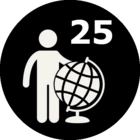Hello,
I have encountered some issues with a workspace that I have not seen addressed previously in the forum. The issue concerns exporting to an SQL server database where the file format is interpreted as GeometryCollection when it is essentially only MultiPolygon at most.
This is what my workflow has looked like.
I have a workspace that retrieves line segments from an SQL server, which are then combined and the attributes processed. These lines are generalized and buffered to form areas. I then use Dissolver to merge overlapping areas with a Group By function based on a common ID (the field INSATSNR in my screenshot).
However, there are several areas with the same ID that are located in different geographical locations and do not overlap. Therefore, I use an Aggregator with a Group By function on the same ID. This ensures that areas with the same ID are collected in one field in the attribute table—exactly as I want it.
However, when I want to export the areas to another SQL database, the correct number of features is exported, but when I then open the layer in QGIS, it is listed as the file type GeometryCollection and no features are displayed in the map image. I therefore believe that something seems to have gone wrong in the export.
I have troubleshot by
- Removing all donuts and building new surfaces using AreaBuilder.
- Including GeometryValidator after Aggregator. The result is that all surfaces are OK and none needed repairing.
- I tried to extract the geometry and replace it, but it didn't work.
- In Dissolver, I used both Deaggregate and Reject as Aggregate Handling. Areas with multiple regions were rejected when that setting was active, but I couldn't aggregate them without using Aggregator.
- I have filtered the geometry in various ways, but I can only conclude that FME perceives the layer's attributes as fme_area but with the geometry type fme_aggregate.
And this is where I start to wonder if the problem is the geometry type fme_aggregate? Our database can handle layers with multiple surfaces, but then as the file type multi polygon. I would like to be able to determine the geometry type, as you can do when writing to geopackage, for example. As far as I know, this is not possible when writing to a database.
My question is therefore whether others have encountered this problem? I also wonder if there is a way to work around this problem without using Aggregator but still get a final result where surfaces with the same ID number are merged in the attribute table?






